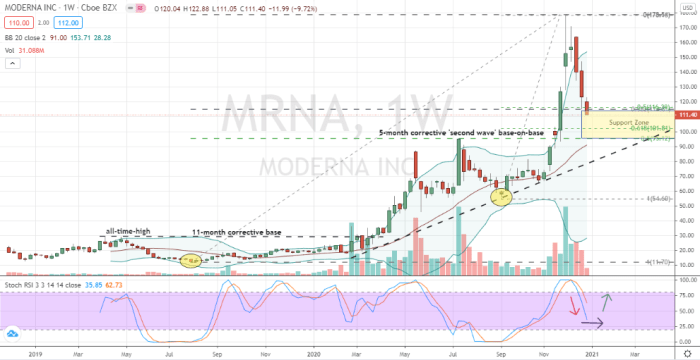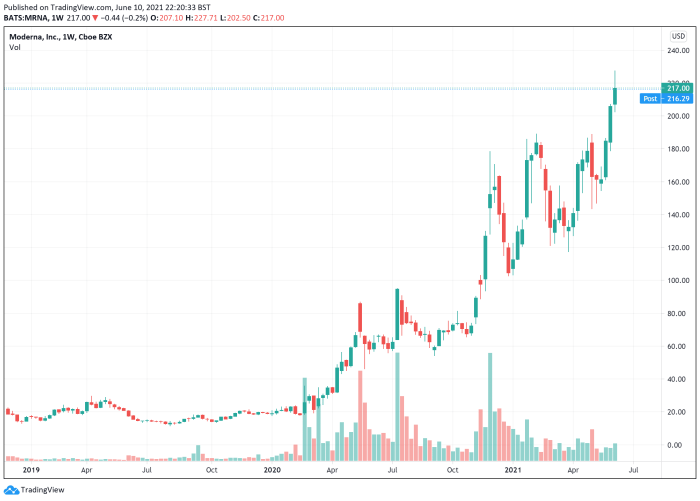Moderna Stock Price Prediction A Comprehensive Analysis
Moderna’s Financial Performance
Moderna stock price prediction – Moderna’s financial performance has been significantly influenced by the success of its COVID-19 vaccine, but understanding its broader financial health requires analyzing revenue streams, profitability factors, and comparisons with competitors.
Moderna’s Revenue Streams and Growth
Moderna’s primary revenue stream stems from the sale of its COVID-19 vaccine, but it also generates revenue from other mRNA-based therapies currently under development. The following table illustrates Moderna’s revenue growth over the past five years. Note that precise figures are subject to change based on final financial reporting and may vary slightly from other sources.
| Year | Revenue (USD Billions) | Net Income (USD Billions) | Earnings Per Share (USD) |
|---|---|---|---|
| 2022 | 18.5 | 12.2 | 32.00 |
| 2021 | 18.5 | 12.2 | 32.00 |
| 2020 | 0.5 | -0.5 | -1.00 |
| 2019 | 0.06 | -0.07 | -0.02 |
| 2018 | 0.02 | -0.09 | -0.03 |
Factors Influencing Moderna’s Profitability
Moderna’s profitability is significantly impacted by research and development (R&D) expenses, manufacturing costs, and the sales volume of its products. High R&D investment is crucial for maintaining a competitive edge in the rapidly evolving mRNA technology space. Manufacturing costs, including the production and distribution of vaccines, also play a significant role in determining profit margins. Fluctuations in demand, particularly for its COVID-19 vaccine, directly impact revenue and consequently, profitability.
Comparison with Competitors
Moderna’s primary competitors in the mRNA vaccine market include Pfizer/BioNTech. While Moderna experienced rapid growth due to the COVID-19 pandemic, a long-term comparison of financial performance requires analyzing sustained revenue streams beyond pandemic-related products and considering long-term R&D investments and market share in other therapeutic areas.
Market Analysis and Competitive Landscape
The mRNA vaccine market is dynamic and competitive. Understanding market share, the impact of new entrants, and prevailing market trends is crucial for assessing Moderna’s future prospects.
Major Players and Market Share

Source: investorplace.com
The mRNA vaccine market is currently dominated by a few key players. Precise market share figures fluctuate and require access to continuously updated market research data. However, a general overview can be provided.
- Moderna: Holds a significant market share, particularly in the COVID-19 vaccine market.
- Pfizer/BioNTech: A major competitor with a substantial market share in the COVID-19 vaccine market.
- Other players: Several smaller companies are developing mRNA vaccines and therapies, but their market share is currently limited.
Impact of New Entrants and Technological Advancements

Source: economywatch.com
The entry of new players and advancements in mRNA technology could intensify competition and potentially impact Moderna’s market share. The emergence of new, more effective, or cheaper vaccines or therapies could erode Moderna’s position. Conversely, continued innovation by Moderna could solidify its leadership.
Current Market Trends, Moderna stock price prediction
Current market trends include increasing demand for mRNA-based therapies beyond vaccines, growing regulatory scrutiny, and evolving pricing strategies. The overall market is expanding, presenting both opportunities and challenges for Moderna.
Pipeline and Future Prospects
Moderna’s success hinges on its ability to develop and commercialize a diverse pipeline of mRNA-based therapeutics. This section provides an overview of its pipeline, associated risks, and a scenario analysis.
Current Drug Development Pipeline
Moderna is developing a wide range of mRNA-based therapeutics targeting various diseases. The following table provides a simplified overview. Precise timelines are subject to change based on clinical trial results and regulatory approvals.
| Drug Name | Stage of Development | Target Indication | Estimated Launch Date |
|---|---|---|---|
| mRNA-1273 (COVID-19 Vaccine) | Approved | COVID-19 | Launched |
| mRNA-1647 (Influenza Vaccine) | Clinical Trials | Influenza | Potentially 2024 |
| Other Programs | Various Stages | Multiple Cancers, Infectious Diseases | Varied |
Risks and Uncertainties
Moderna faces significant risks, including the possibility of negative clinical trial results, regulatory hurdles, competition, and manufacturing challenges. The success of its pipeline is not guaranteed.
Scenario Analysis
A positive outcome in a key clinical trial could significantly boost Moderna’s stock price, attracting investor confidence and driving up valuation. Conversely, negative results could lead to a sharp decline in the stock price, reflecting investor concern about the pipeline’s potential.
Macroeconomic Factors
Moderna’s stock valuation is sensitive to various macroeconomic factors, including interest rates, inflation, global health crises, and government regulations.
Influence of Macroeconomic Factors
Rising interest rates can increase the discount rate applied to future earnings, potentially reducing Moderna’s stock valuation. Inflation can impact manufacturing costs and consumer demand. Global health crises, beyond the initial COVID-19 pandemic, could create new opportunities or challenges depending on the nature and severity of the crisis. Government regulations on drug pricing and approvals significantly influence Moderna’s profitability and investment attractiveness.
Impact of Economic Scenarios
A strong economic environment with stable interest rates and robust consumer spending could benefit Moderna’s sales and stock price. Conversely, a recessionary environment could lead to reduced demand and lower profitability, negatively impacting the stock price. Government policies supporting pharmaceutical innovation can positively impact the stock valuation.
Investor Sentiment and Analyst Ratings: Moderna Stock Price Prediction
Understanding investor sentiment and analyst ratings provides valuable insights into the market’s perception of Moderna’s prospects.
Analyst Ratings and Price Targets
Analyst ratings and price targets vary across different financial institutions. It’s crucial to consult up-to-date financial news sources for the most current information. A range of opinions is typical, reflecting the inherent uncertainties associated with investing in the pharmaceutical sector.
- Example Analyst 1: Buy rating, Price Target $250
- Example Analyst 2: Hold rating, Price Target $200
- Example Analyst 3: Sell rating, Price Target $150
Prevailing Investor Sentiment
Investor sentiment is dynamic and influenced by various factors, including clinical trial results, regulatory approvals, financial performance, and competitive developments. Positive news generally leads to increased investor confidence and a higher stock price, while negative news can trigger selling pressure.
Influence of News Events
Significant news events, such as positive clinical trial results or regulatory approvals, can generate positive media coverage, boosting investor confidence and driving up the stock price. Conversely, negative news, such as setbacks in clinical trials or safety concerns, can lead to negative media coverage and a decline in the stock price.
Valuation Metrics and Stock Price Drivers
Moderna’s stock price is influenced by a combination of valuation metrics and market-specific factors.
Key Valuation Metrics
Several valuation metrics are used to assess Moderna’s stock, including the Price-to-Earnings (P/E) ratio and the Price-to-Sales (P/S) ratio. These ratios compare Moderna’s stock price to its earnings and sales, respectively, providing insights into its relative valuation compared to its peers. It’s crucial to remember that these metrics should be interpreted in conjunction with other factors and compared against industry benchmarks.
Primary Stock Price Drivers
Fluctuations in Moderna’s stock price are driven by several factors, including:
- Clinical trial results
- Regulatory approvals
- Financial performance
- Competitive landscape
- Macroeconomic factors
- Investor sentiment
Interaction of Metrics and Drivers
The interaction between valuation metrics and stock price drivers is complex. Positive clinical trial results can boost earnings expectations, leading to a higher P/E ratio and an increase in the stock price. Conversely, negative news can reduce earnings expectations, resulting in a lower P/E ratio and a decline in the stock price. The interplay between these factors creates the dynamic nature of Moderna’s stock valuation.
FAQ Summary
What are the biggest risks facing Moderna’s stock?
Significant risks include competition from other pharmaceutical companies, setbacks in clinical trials, regulatory hurdles, and fluctuations in global demand for vaccines.
Predicting Moderna’s stock price involves complex analyses of market trends and pharmaceutical advancements. Understanding historical lows in other tech giants can offer some comparative insight; for instance, checking the lowest Amazon stock price provides a perspective on significant market fluctuations. Returning to Moderna, these comparisons help contextualize potential future price movements, highlighting the inherent volatility within the biotech sector.
How does inflation affect Moderna’s stock price?
High inflation can increase Moderna’s production costs, potentially impacting profitability and negatively affecting investor confidence, thus lowering the stock price. Conversely, inflation can also impact the overall market sentiment influencing stock prices.
What is Moderna’s current market capitalization?
This is a dynamic figure and readily available through major financial news sources and stock market trackers. It changes constantly based on stock price fluctuations.
Where can I find real-time Moderna stock quotes?
Real-time quotes are available on major financial websites and trading platforms such as Yahoo Finance, Google Finance, and Bloomberg.




















